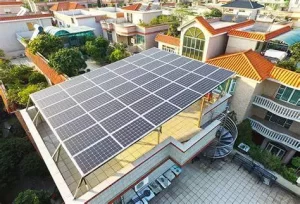The Synergy of Solar Power and Battery Storage: Transforming Energy Consumption
In the quest for sustainable energy solutions, the combination of solar power and battery storage has emerged as a game-changer. This synergy not only addresses the intermittency of solar energy but also enhances energy security, cost savings, and environmental benefits. As the world moves towards cleaner energy sources, understanding the profound impact of integrating solar power with battery storage is crucial.

Harnessing Solar Power
Solar Energy Basics
Solar power is harnessed from the sun’s rays using photovoltaic (PV) panels, which convert sunlight into electricity. This clean, renewable energy source is abundant and accessible, making it an attractive option for reducing reliance on fossil fuels.
Growth of Solar Power
The adoption of solar power has seen exponential growth due to falling costs of PV panels and supportive government policies. Residential, commercial, and utility-scale solar installations are becoming commonplace, contributing to a significant increase in global solar capacity.
The Role of Battery Storage
Addressing Intermittency
One of the main challenges of solar power is its intermittency—solar panels only generate electricity when the sun is shining. Battery storage systems overcome this limitation by storing excess energy generated during sunny periods and releasing it when needed, such as during cloudy days or at night.
Types of Batteries
Various types of batteries are used for energy storage, with lithium-ion batteries being the most popular due to their high energy density, efficiency, and decreasing costs. Other types include lead-acid, flow batteries, and emerging technologies like solid-state batteries.
Benefits of Combining Solar Power with Battery Storage
Energy Independence
By integrating solar power with battery storage, consumers can achieve greater energy independence. They can generate and store their own electricity, reducing dependence on the grid and protecting against power outages.
Cost Savings
Battery storage allows consumers to maximize the use of their solar energy, reducing reliance on grid electricity and lowering energy bills. Additionally, with time-of-use pricing, stored solar energy can be used during peak demand periods when electricity rates are higher, further increasing savings.
Environmental Impact
The combination of solar power and battery storage significantly reduces carbon emissions by decreasing reliance on fossil fuels. This contributes to a cleaner environment and helps combat climate change.
Grid Stability and Resilience
Battery storage enhances grid stability by providing ancillary services such as frequency regulation and voltage support. It also increases grid resilience by supplying backup power during emergencies, ensuring continuous electricity supply.
Real-World Applications
Residential Use
Homeowners are increasingly adopting solar power systems paired with battery storage to achieve energy self-sufficiency. Systems like the Tesla Powerwall and LG Chem RESU offer convenient solutions for storing solar energy and using it when needed.
Commercial and Industrial Use
Businesses are leveraging solar power and battery storage to reduce operational costs and enhance energy reliability. Large-scale installations can offset significant portions of energy consumption, providing a hedge against volatile energy prices.
Utility-Scale Projects
Utility companies are investing in large-scale solar and battery storage projects to provide reliable, clean energy to the grid. These projects help manage peak demand, reduce transmission losses, and support renewable energy integration.
Challenges and Future Directions
Initial Costs
The initial investment for solar power systems and battery storage can be high, posing a barrier to adoption. However, declining costs and financing options are making these technologies more accessible.
Technological Advancements
Continuous advancements in battery technology, such as improved energy density, longer lifespan, and faster charging times, are crucial for the widespread adoption of solar power and storage solutions.
Policy and Incentives
Supportive policies and incentives play a vital role in promoting the adoption of solar power and battery storage. Governments and regulatory bodies need to provide favorable frameworks to accelerate the transition to clean energy.
Integration and Management
Effective integration of solar power and battery storage into the existing grid requires sophisticated energy management systems. These systems ensure efficient energy distribution, minimize losses, and optimize the use of stored energy.
Conclusion
The integration of solar power and battery storage represents a transformative step towards a sustainable energy future. By addressing the intermittency of solar energy, enhancing energy security, and providing cost savings, this synergy is reshaping the way we generate, store, and consume electricity. As technology advances and adoption increases, solar power and battery storage will play a pivotal role in achieving a cleaner, more resilient, and efficient energy landscape.
Contact us
- Email:[email protected]
- Tel: +86 13651638099
- Address: 333 Fengcun Road, Fengxian District, Shanghai
Get A Quote Now!

Read more

Unveiling Photovoltaic+Energy Storage: Four Major Application Scenarios Leading the Future of Energy
In this way, the energy landscape is evolving, and one of the most thrilling developments in renewables is the integration of photovoltaics energy storage.

From Theory to Practice: Four Methods for Estimating Photovoltaic Power Generation
Photovoltaic power generation has become an essential part of modern energy solutions, particularly in home solar systems and distributed power applications

Rack-Mounted Lithium Iron Batteries: Creating Efficient and Reliable Energy Storage Solutions
When it comes to modern energy solutions, rack-mounted lithium iron batteries are taking center stage in a variety of industries. Whether you’re powering data centers, stabilizing energy for households, or keeping critical systems online at 5G base stations, these batteries have become the unsung heroes of our electrified world.

Late Night Energy Saving Tips: How to Maximize Electricity Savings During Off-Peak Hours
With rising energy costs, homeowners are increasingly exploring innovative ways to save on their electricity bills. One effective approach is utilizing off-peak hours—times when electricity rates are significantly lower due to reduced demand.
